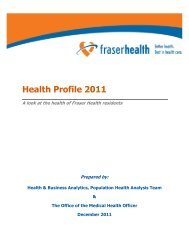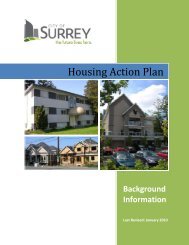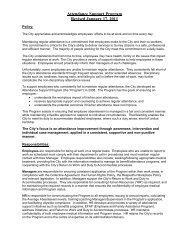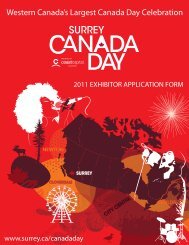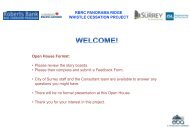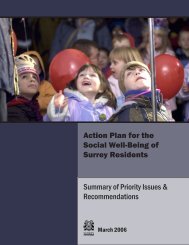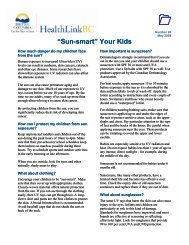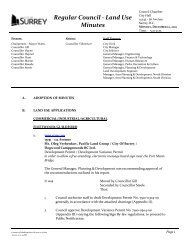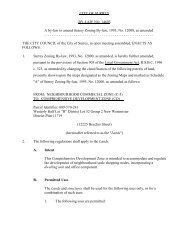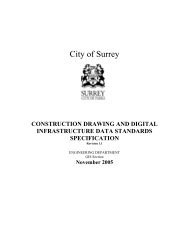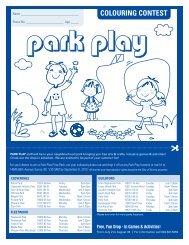Blackie Spit Park: Wildlife Habitat Enhancement Plan - City of Surrey
Blackie Spit Park: Wildlife Habitat Enhancement Plan - City of Surrey
Blackie Spit Park: Wildlife Habitat Enhancement Plan - City of Surrey
Create successful ePaper yourself
Turn your PDF publications into a flip-book with our unique Google optimized e-Paper software.
Management Unit 12: East Pod<br />
1.0 Existing Conditions<br />
Management Unit 12 is a roughly triangular unit consisting <strong>of</strong> a central, open sandy area surrounded<br />
with a tree/shrub border (Drawing 9) (Figure 34). The vegetation <strong>of</strong> the central area is sparse grasses<br />
and forbs, including plantain, goldenrod, hairy cat’s ear, sweet clover and some invasive species,<br />
including broom. Also in the centre is a single, 21 m high, multi stemmed cottonwood, beneath which<br />
seedling cottonwoods and the invasive species, daphne, are growing (Figure 34, left side). The centre<br />
<strong>of</strong> the south tip has denser vegetation with, in addition to the foregoing species, cow parsnip<br />
(Heracleum lanatum), two species <strong>of</strong> thistle, blackberry, and black cottonwood.<br />
Along the south perimeter the major tree species are Pacific crabapple and birch, with one large<br />
willow (Figure 34, left background). Smaller trees and shrubs include red elderberry, red-osier<br />
dogwood, black hawthorne, salmonberry, and blackberry. The most abundant forb is goldenrod.<br />
An introduced tree species, possibly cedar elm (Ulmus crassifolia), grows to a height <strong>of</strong> 9 m along<br />
the northeast perimeter, from where it is encroaching into the central open area (Figure 35). That<br />
species is also the main tree species along the northwest border, where it grows to 14 m high. Other<br />
species along the northwest side, mostly toward the west end, are Pacific crabapple, a species <strong>of</strong><br />
cherry, black hawthorne, and shrubs, such as snowberry and daphne.<br />
2.0 Goals and Objectives<br />
Species Management Goal<br />
• Dry habitat: White-crowned sparrow nesting; sparrow wintering and migration<br />
• Treed areas: accipiters, passerines (warblers, sparrows, thrushes), eventual perches for bald<br />
eagles and red-tailed hawks in isolated cottonwoods or alders.<br />
<strong>Habitat</strong> Management Objectives<br />
• Maintain free flyways into the estuarine bays <strong>of</strong> MU1 by controlling the spread <strong>of</strong> invasive<br />
woody vegetation in both open sandy areas and understorey <strong>of</strong> treed areas (e.g. alder,<br />
cottonwood, exotic elm);<br />
• Remove all woody vegetation in the open, central area (except the existing clump <strong>of</strong><br />
cottonwoods);<br />
• Permit only native shrubs to grow beneath the trees in the central and perimeter areas;<br />
• Control daphne, broom and any other invasive species as part <strong>of</strong> the above two points;<br />
• Restrict trails to perimeter;<br />
• Exclude dogs (to prevent disturbance to ground-nesting birds and estuarine birds);<br />
• Fence viewing area at south tip to discourage access to estuary.<br />
3.0 Management Prescriptions<br />
3.1 Initial <strong>Enhancement</strong> Requirements<br />
• Construct a fence and erect signs to block access to the estuary at the south tip <strong>of</strong> the pod.<br />
<strong>Blackie</strong> <strong>Spit</strong> <strong>Park</strong>: <strong>Wildlife</strong> <strong>Habitat</strong> <strong>Enhancement</strong> <strong>Plan</strong> – Management Unit 12 60



